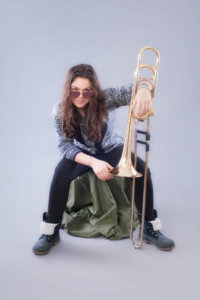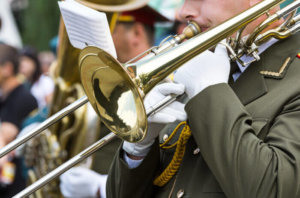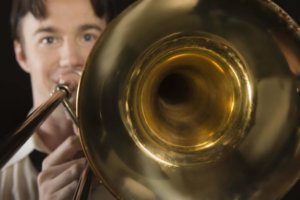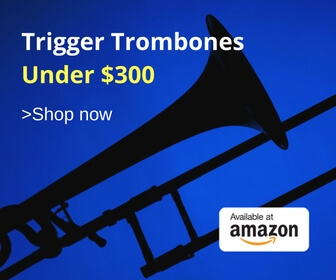Ready for your first trigger trombone or need an upgrade? Our Trigger Trombone Guide will take you through everything you need to know about the tenor trombone with f-attachment, from open or traditional wrap, to string or mechanical linkage.
Which trombone is right for you? Check out our Trigger Trombone Reviews for all the pros and cons on the foremost brands like Bach, Conn, King, Holton, Blessing, and Yamaha.
Five Star Trigger Trombones on Amazon
Why the F-Trigger Attachment?
There are two advantages to using a tenor trombone with an f-trigger attachment: one is musical and the other is operational
-
 The Musical Advantage
The Musical Advantage
Straight tenor trombones are pitched in the key of Bb which gives it the chromatic range of E below the bass clef to Bb above the middle C. When you attach extra tubing, typically pitched in the key of F and accessed through a trigger operated valve, you then extend the chromatic range of the trombone down to low C, or by a perfect 5th. In other words, you have a very flexible instrument with a wide range.
- The Operational Advantage
Intermediate trombonists who are advancing from a straight slide trombone to the F attachment find a trigger trombone much easier to play. You can access notes higher up on the slide that are played further down the slide on a straight trombone. For example, F which is played in the 6th position can be played in the first position with a trigger. Advanced trombonists love the quicker access to notes as they are accessible in different positions with the trigger.
Value Priced Trigger Trombones on Amazon
History of the Trigger Trombone
Trigger trombones (those with an F attachment) are a mechanical modification of the straight slide trombone. The modern trombone evolved from a 15th century Englinsh instrument called a sackbut which looks very similar to a straight tenor trombone.
 Many historians agree that the first brass instrument with a slide was a smaller, higher pitched instrument like a trumpet and the hand slide was later applied to the sackbut which eventually evolved to the slide trombone. Traditionally, the tone produced by a trombone was accomplished strictly through adjustments in slide and embouchure. Due to simplicity of design, a typical ochestral trombone section consisited of an alto in E flat, a tenor in B flat, and a bass in F.
Many historians agree that the first brass instrument with a slide was a smaller, higher pitched instrument like a trumpet and the hand slide was later applied to the sackbut which eventually evolved to the slide trombone. Traditionally, the tone produced by a trombone was accomplished strictly through adjustments in slide and embouchure. Due to simplicity of design, a typical ochestral trombone section consisited of an alto in E flat, a tenor in B flat, and a bass in F.
In 1839, a German instrument maker by the name of Christian Friedrich Sattler recognized that he could add tubing within the bell section of a Bb tenor trombone to access the range produced by an F bass trombone thus combining two intruments into one. The added tubing which could turn the Bb tenor into an F bass was actuated by a trigger operated by the thumb. Ever since, this has been the basic design of the Bflat/F trombone, also known as the F-attachment or trigger trombone.
Bach Trigger Trombones on Amazon
Trigger Trombone Demonstration
Triggerology (Glossary)
Terminology, parts, and other things you need to know about the trigger trombone.
Bell: The bell is the flaring end of the instrument from whence the sound comes. The taper of the bell effects the sound. The more gradual the taper, the darker the tone.
Bell Section: The section of the trombone that disconnects from the slide.
 Bore: The bore is the inside width of the tubing of a trombone. The bore maintains a consistent width from the leadpipe, through the slide, and to the point that the bell section begins to flare. The wider the bore, the deeper the sound. A striaght tenor trombone can have bore size anywhere from .468″ to .509″ A closed wrap trigger trombone typically has a bore size of .525″ and an open wrap trigger trombone usually has a bore size of .547″. Also, the tubing of the f-attachment often a little wider than the bore of the straight part of the trombone.
Bore: The bore is the inside width of the tubing of a trombone. The bore maintains a consistent width from the leadpipe, through the slide, and to the point that the bell section begins to flare. The wider the bore, the deeper the sound. A striaght tenor trombone can have bore size anywhere from .468″ to .509″ A closed wrap trigger trombone typically has a bore size of .525″ and an open wrap trigger trombone usually has a bore size of .547″. Also, the tubing of the f-attachment often a little wider than the bore of the straight part of the trombone.
Dual Bore: Some trombones have slides where the upper bore is less wide than the lower bore. This allows for less air volume than is required for a larger bore horn while still sounding darker and mellower like a larger bore horn.
Embouchure: The way your lips form and press against the mouthpiece.
F Attachment: The extra tubing added to the bell section of a trigger trombone that changes the instrument from the key of B flat to the key of F.
Gooseneck: The crook in the tubing that goes from the slide to the bell.
Handgrip: The brace between the two sections of slide or the inner brace of the trombone.
Yamaha Trigger Trombones on Amazon
Harmonic: Notes you can play on an instrument without moving valves or slides.
Intonation: The ability, or lack thereof, of an instrument to stay in tune.
Leadpipe: Also called the mouthpipe, the leadpipe is the small section of tubing between the slide and the mouthpiece. Most leadpipes are fixed or soldered onto the slide section of the instrument but some trombone models do allow for interchangeable leadpipes.
Mouthpiece: Using different mouthpieces on the same instrument effects your embouchure and therefore the sound coming out of the instrument. Before changing mouthpieces, make sure the bore of the mouthpiece matches the bore of the instrument.
Reciever: Also called the venturi, this is where you stick the mouthpiece.
Resistance: The effort it takes to make air flow through the horn. When opened, an f-attachment creates more resistance due to the added length of tubing and the bends in that tubing.
Slide: the part of a trombone that the player moves back and forth to play different notes. Yeah, kind of obvious.
Conn Trigger Trombones on Amazon
Spit valve: This allows you to drain condensation from out of your horn. Politer people call it the water key.
Slide lock: Stops the slide from moving when unattended.
Stockings: The ever so slightly wider ends of an inner slide.
Straight Trombone: A basic trombone without the F-attachment.
Tenor Trombone: The most common type of trombone that plays in the key of B flat. Add the and it will also play in the key of F.
Trigger: The thumb operated lever that opens and closes the valve to the F attachement.
Trigger Trombone: A tenor trombone with F-attachment operated by a trigger.
Throw: The distance the trigger must be pressed to completely open the valve.
Valve: The valve is the mechanism by which the airflow of the trombone is redirected from flowing through the straight part of the trombone to flowing through the F attachment and back into the bell
Tuning slide: F attachments usually have an adjustable slide to adjust the pitch of the instrument. As the metal of any brass instrument responds to changes in its playing environment such as external temperature, internal temperature, or even humidity, the pitch of the instrument will change.
Wrap: The tubing that makes up the F-attachment.
Intermediate Trigger Trombones on Amazon
More Resources:
Trigger Trombone Recommends:

